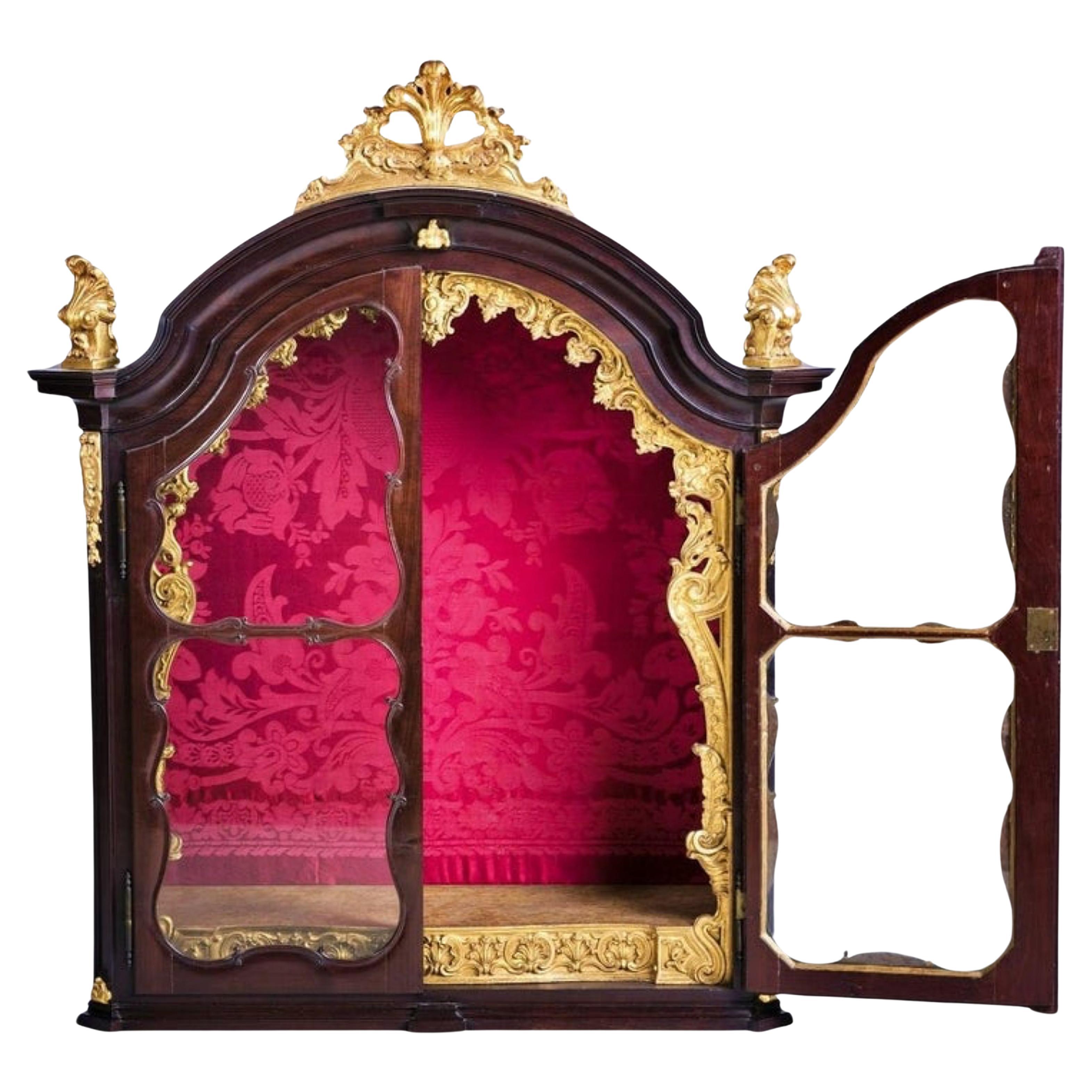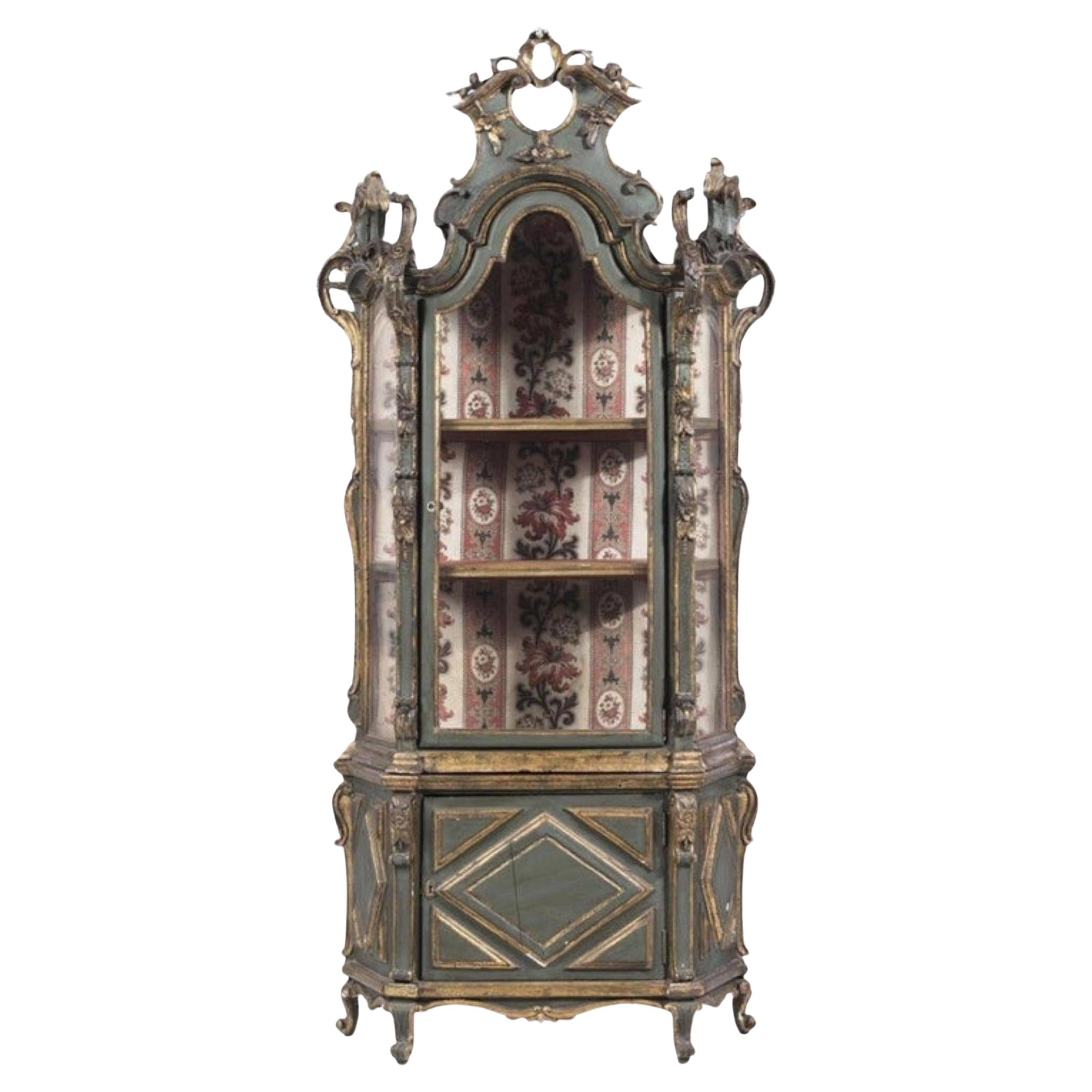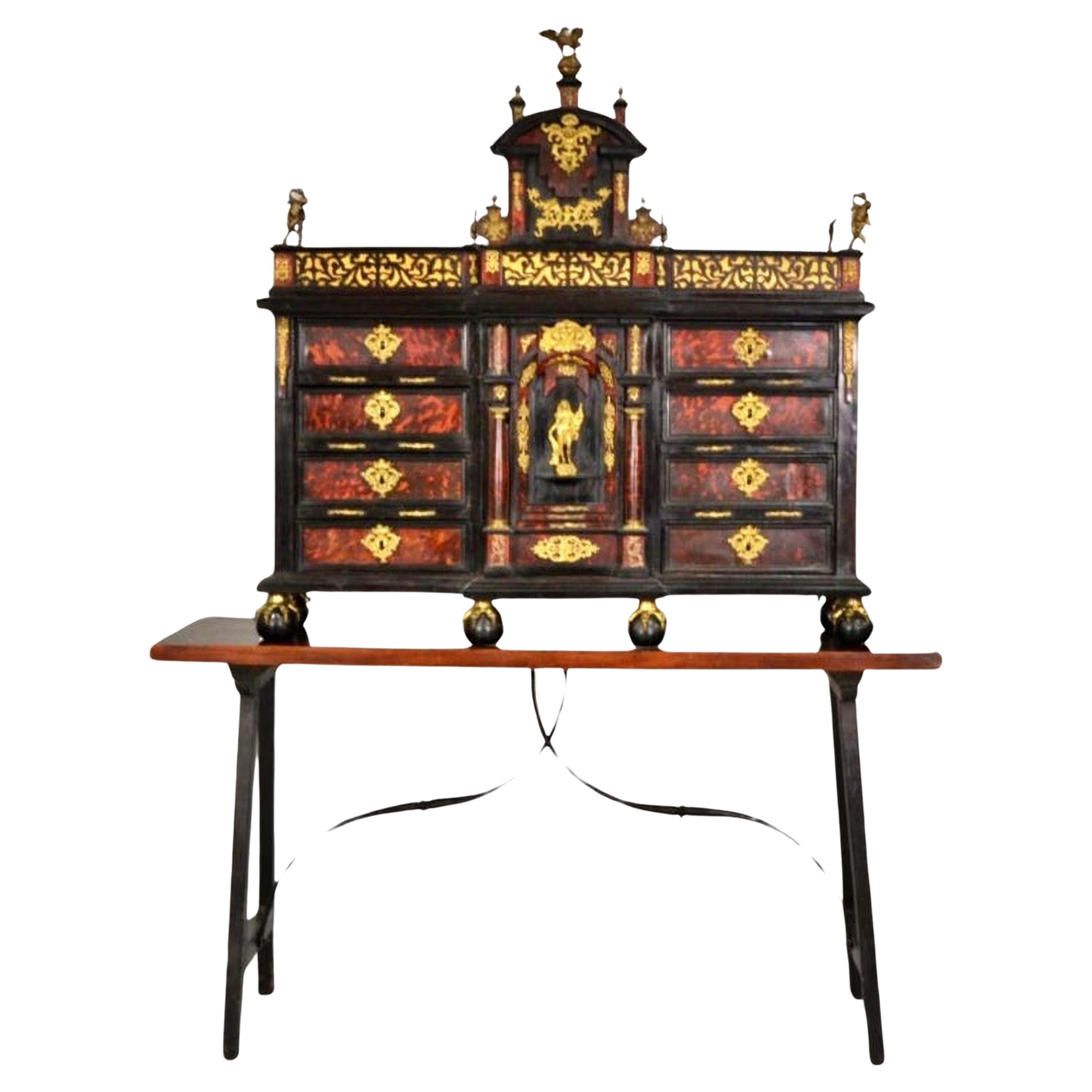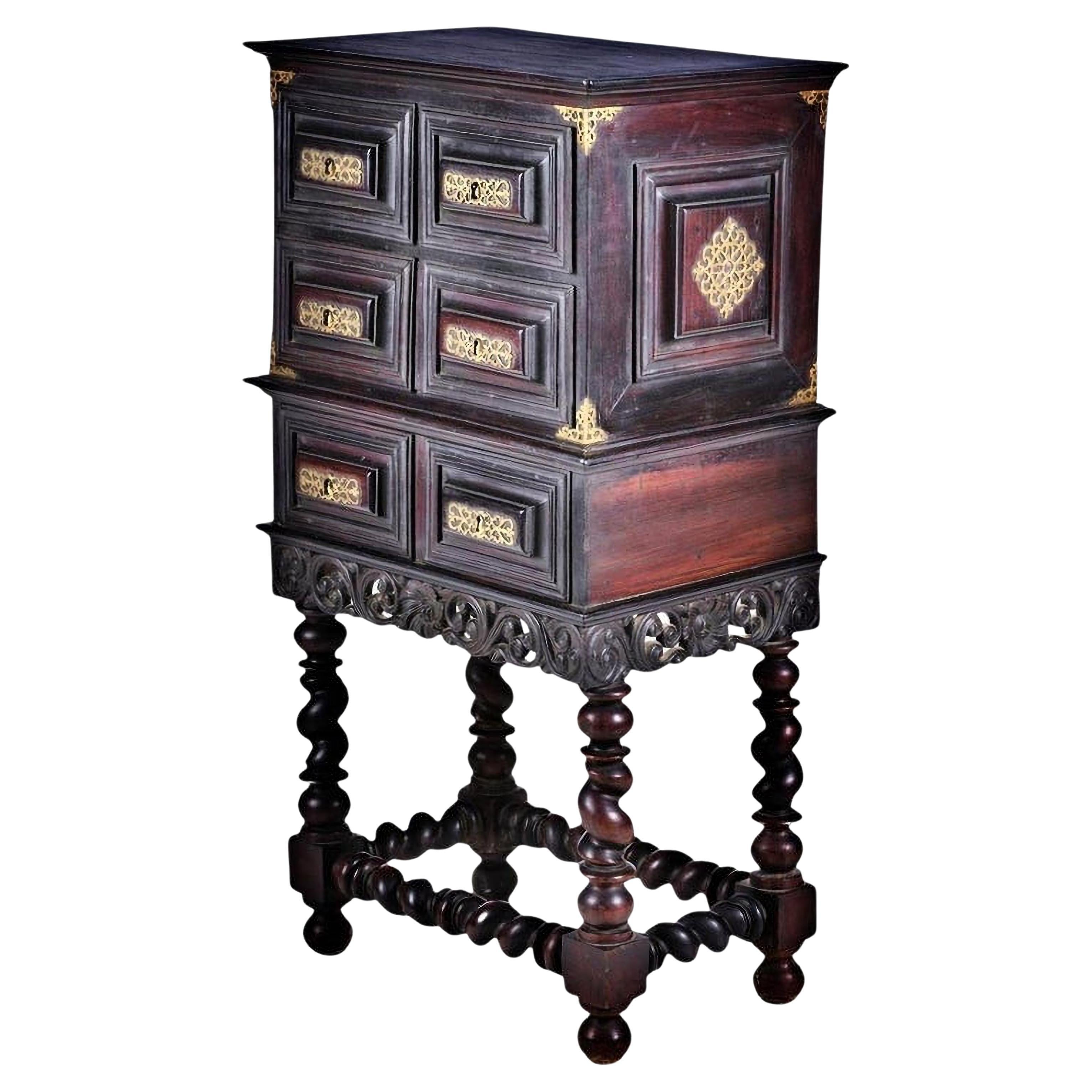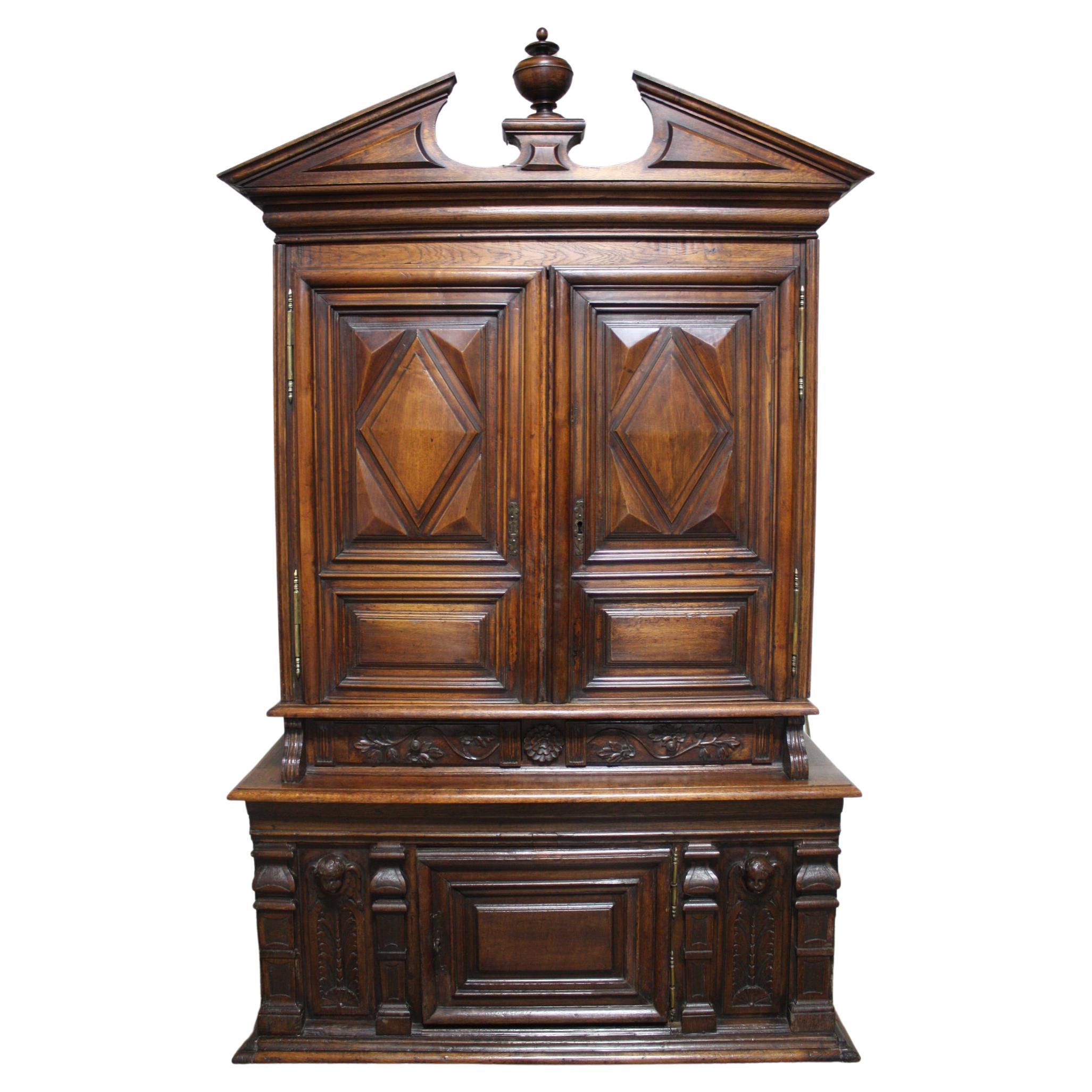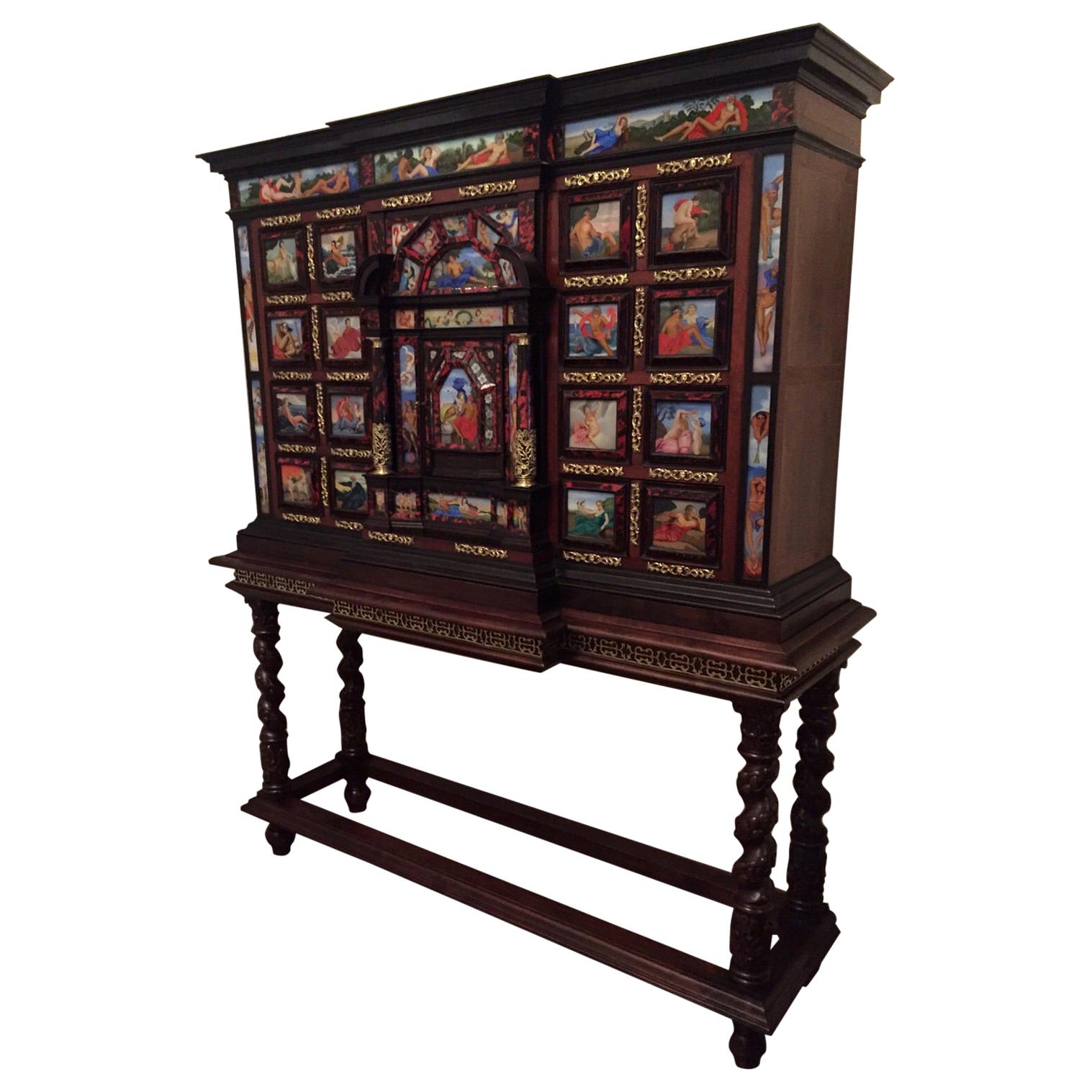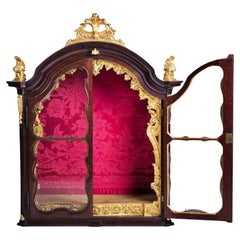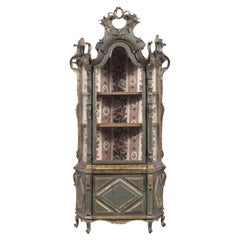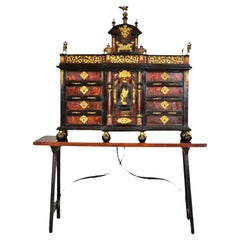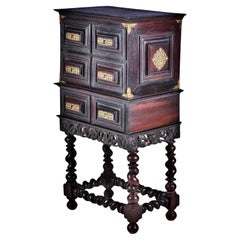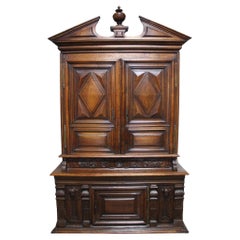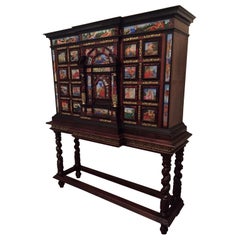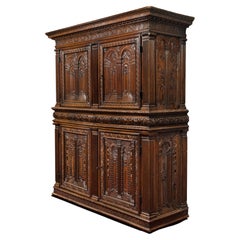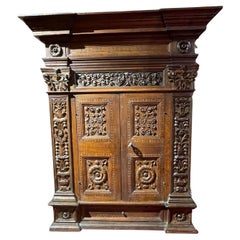Items Similar to IMPORTANT LARGE PORTUGUESE ORATORY 17th Century
Want more images or videos?
Request additional images or videos from the seller
1 of 6
IMPORTANT LARGE PORTUGUESE ORATORY 17th Century
$8,120.89
$10,151.1120% Off
£6,005.14
£7,506.4320% Off
€6,800
€8,50020% Off
CA$11,154.82
CA$13,943.5320% Off
A$12,403.52
A$15,504.4120% Off
CHF 6,493.47
CHF 8,116.8420% Off
MX$151,511.37
MX$189,389.2120% Off
NOK 81,596.84
NOK 101,996.0420% Off
SEK 76,758.18
SEK 95,947.7220% Off
DKK 51,776.76
DKK 64,720.9520% Off
About the Item
IMPORTANT LARGE PORTUGUESE ORATORY 17th Century
in carved and turned Brazilian rosewood with remains of gilding, glass doors and sides.
Interior with painted, polychrome and gold decoration.
Small defects.
Dim.: 180 x 110 x 52 cm
- Dimensions:Height: 70.87 in (180 cm)Width: 43.31 in (110 cm)Depth: 20.48 in (52 cm)
- Style:Renaissance (Of the Period)
- Materials and Techniques:
- Place of Origin:
- Period:
- Date of Manufacture:17th century
- Condition:Wear consistent with age and use. very good condition for the age.
- Seller Location:Madrid, ES
- Reference Number:1stDibs: LU5779237566162
About the Seller
4.8
Platinum Seller
Premium sellers with a 4.7+ rating and 24-hour response times
Established in 2005
1stDibs seller since 2021
371 sales on 1stDibs
Typical response time: 1 hour
- ShippingRetrieving quote...Shipping from: Madrid, Spain
- Return Policy
Authenticity Guarantee
In the unlikely event there’s an issue with an item’s authenticity, contact us within 1 year for a full refund. DetailsMoney-Back Guarantee
If your item is not as described, is damaged in transit, or does not arrive, contact us within 7 days for a full refund. Details24-Hour Cancellation
You have a 24-hour grace period in which to reconsider your purchase, with no questions asked.Vetted Professional Sellers
Our world-class sellers must adhere to strict standards for service and quality, maintaining the integrity of our listings.Price-Match Guarantee
If you find that a seller listed the same item for a lower price elsewhere, we’ll match it.Trusted Global Delivery
Our best-in-class carrier network provides specialized shipping options worldwide, including custom delivery.More From This Seller
View AllPORTUGUESE ORATORY 18th Century
Located in Madrid, ES
PORTUGUESE ORATORY
18th Century
in mahogany wood with gilding. Glass doors. Interior with apricot.
Dim.: 155 x 120 x 47 cm.
good conditions
Category
Antique 18th Century Portuguese Baroque Vitrines
Materials
Wood
$5,254 Sale Price
20% Off
Portuguese Mobile Oratory, 19th Century
Located in Madrid, ES
Mobile Oratory
19th century,
in painted and gilded carved wood. Interior painted with two shelves.
Dim.: 194 x 85 x 38 cm.
Good condition.
Category
Antique Early 19th Century Portuguese Baroque Cabinets
Materials
Wood
$3,343 Sale Price
20% Off
Important Spanish Cabinet, 17th Century
Located in Madrid, ES
Important Spanish Cabinet 17th century
in blackened wood and tortoiseshell veneer.
It opens with eight drawers framing a central door, surrounded by two columns.
Richly decorated w...
Category
Antique 17th Century Spanish Baroque Cabinets
Materials
Bronze
$9,076 Sale Price
20% Off
Rare Portuguese 18th Century Cabinet
Located in Madrid, ES
Portuguese 18th century cabinet
Made of kingwood.
Three drawers simulating four.
Base with profusely decorated skirts with plant motifs, turned legs and beams. Hardware and fittings ...
Category
Antique 18th Century Portuguese Baroque Cabinets
Materials
Wood
$5,254 Sale Price
20% Off
RENAISSANCE TWO BODY CABINET 19th Century
Located in Madrid, ES
RENAISSANCE TWO BODY CABINET 19th Century
In oak wood
Upper part with two profusely carved doors.
Lower part with two drawers and two doors.
Decorated with plant motifs, zoomorphic ...
Category
Antique 19th Century Portuguese Baroque Cabinets
Materials
Wood
$8,885 Sale Price
20% Off
AMAZING Portuguese 18th Century CUPBOARD
Located in Madrid, ES
Portuguese 18th Century CUPBOARD
built with gilded and painted elements from the 19th century. XVIII. With two doors, interior with shelves.
Small defects.
Dim.: 173 x 125 x 44 cm
g...
Category
Antique 18th Century Portuguese Rococo Cupboards
Materials
Wood
$7,165 Sale Price
20% Off
You May Also Like
French 17th Century Cabinet
Located in Stockbridge, GA
What a wonderful piece, full of character with the ornaments at the base and the putties carved in the wood.
Category
Antique Late 17th Century French Renaissance Cabinets
Materials
Oak, Walnut
Original 18th Century Monumental Cabinet on Stand / Italian Bargueno / European
Located in Miami, FL
Important monumental cabinet on stand.
The case of the cabinet is walnut, veneered with rich rib boned ebony and luxuriously decorated with turtle ...
Category
Antique Late 18th Century Italian Baroque Cabinets
Materials
Walnut, Glass
Important Renaissance Cabinet from Lyon 'France' with a Decor of Perspectives
Located in Saint-Ouen, FR
As soon as 1540 France's second Renaissance is in the making, intimately linked to the rediscovery of the Antique world. The development of the printing and engraving industry allows the spread of artworks and models in many cities and countries. The Italian influence can be perceived in every artistic field. While the French king entrust the most talented Italian artists with major projects such as Il Rosso or Primaticcio in Fontainebleau, French artists also travel to Italy to form themselves to this new style. In Italy they get acquainted with the work of Leo Battista Alberti the first to theorize perspective (De Pictura, 1435-36) and architecture (De re oedificatoria, 1541). Those two publications would have a revolutionary impact on arts.
Furniture is marked by the work of the most famous Italian architects of the time as well as French architects. Indeed Philibert de l'Orme competes with Alberti and by the end of his life publishes several treaties including one devoted to a theory of architecture (1567). Unfortunately he would not live to complete the second volume. In this treaty he expresses his interest for mathematical norms applied to architecture, copied from the Antique. His journeys in Italy allowed him to accumulate the most sophisticated references. Jean Bullant, another architect of great talent also theorizes his practice. He establishes rules characterizing Greco-Roman art staying faithful to Vitruvius.
Following this new inspiration the structure of furniture evolves. From then on appear columns, capitals, cornices, friezes and architraves. The ornamentation uses this inspiration as well with egg-and-dart, palm leaf and rose adorning the most beautiful pieces.
In Lyon, crossroad where meet merchants from everywhere those new experiments are welcomed. Lyon florishing printing industry allows the spreading of models and treaties essential to the artist's work. Thus the first publication of Vitruvius' De Architectura in France would be printed in Lyon in 1532.
Artists from Lyon rediscover and familiarize themselves with the Antique knowledge very early. They adopt those new ideas and use them in their own creations. Lyon cabinet-makers re interpret Antique architecture and Italian Renaissance palaces to give their pieces a pure and harmonious architectural structure. Grooved pilasters are particularly favored. They are topped by capitals of diverse orders always respecting the sequencing with simpler ones for the lower levels and the richest ones on the higher levels. As for the ornamentation, one of the great distinctiveness of Lyon workshops remains the architectural perspective illusions, drawing inspiration from Tuscany.
True masterpiece of the Second French Renaissance this important cabinet illustrates Lyon workshops' taste for fine Italian architecture inspired by Antiquity. An architectural perspective of great quality is treated in symmetry on each panel.
This two-bodied cabinet without recess stands on four rectangular feet. The base comprises a molding, a palm leaf frieze and is bordered by a braid.
The lower body is divided by three grooved pilasters with Tuscan capitals framing two door-leaves. The two panels are encircled by a moudled frame with palm leaves. They are finely carved with a decor of fantasized architecture depicting an Italian Renaissance palace erected symmetrically on each side of a grooved pilaster. On the ground floor a door opens through a stilted arch while the stories are opened with mullioned windows, dormers and occuli. Two large pegged-boss cladded pillars support the entablature enriched by a palm leaf frieze upon which stands an arch whose coffered intrados is centred by a rose. Behind this arch a pyramid appears, standing in front of a second facade with a window topped by a broken curvilinear pediment under a cul-de-four with a shell.
The checker flooring gives depth to the low-reliefs creating vanishing points structuring the panels and guiding the eye of the observer.
A thin laurel braid highlights the belt of the cabinet where are located two drawers. Their facades are adorned by palm leaves in hoops.
The upper body is encircled with palm leaves. The same ternary division as in the lower body appears. However, the pilasters are topped by Ionic capitals with volutes and egg-and-dart. The door-leaves are framed with flowers. On the panels the artist has designed another architectural decor. On the foreground open two arches on top of grooved pilasters with rectangular capitals adorned with palm leaves. The arches are enriched with braids and the coffered intrados bears a decor of roses. The spandrels also bear a flower decor. In the background another arcature hosts a fluted grooved column topped with double basket acanthus capital, characteristic of Corinthian order. The triangular pediment is interrupted by a choux bourguignon.
A large cornice crowns the cabinet. It stands on pilasters and forms an entablature comprising a palm leaf frieze and an egg-and-dart, triglyph and palm leaf cornice.
The cabinet's sides have also been carefully considered. The lower body's panels are enriched with an arch rising above a broken pediment portico hosting a twisted column. Flowers garnish the spandrels. An architectural facade completes the decor. The upper body's panels present two arches supported by a facade opened with dormers and mullioned windows as well as cartouches (one bears the inscription 1580 dating the cabinet) suggesting the interior of an Italian Renaissance palace, confirmed by the chandeliers. The flooring leads our gaze to a second arch with a broken curvilinear pediment where stands a flower vase. This arch opens onto a perspective of another facade along a road.
Inside the cabinet, on the lower body door-leaves appear two designs. On the right door is depicted a Crucifixion. Saint Mary and Saint John flank the Christ on the cross. In the bottom part is inscribed « Dure uiator abis nihil haec spectacula curas / Pendenti cum sis unica cura Deo. / Tota suo moriente dolet natura Magistro. / Nil qui solus eras caussa dolenda doles. ». The signature [Christoff Swartz Monachiensis pinx[it] / Ioa[nnes] Sadeler sculp[it]] tells us it was made by Johan Sadeler I (1550-1600) after Christoph Schwartz (1548-1592). This engraving belongs to an ensemble depicting the Passion of Christ Johan Sadeler executed in 1589 after an altar piece painted by Christoph Schwartz for the private chapel of Renée of Loraine, wife of Duke William V of Bavaria. This altar piece made of nine copper panels has been destroyed during the 19th century. The Crucifixion panel once in the centre of the altar piece is the only one that survived and is today kept in Munich's Alte Pinakothek.
On the left door appears Saint Francis receiving the stigmata. The inscription says : « Signastidomine Servum Tuum. Franciscum. Signis Redemptionis Nostrae ».
This Renaissance cabinet with an architectural decor appearing as much in the structure faithful to Antique rules...
Category
Antique 16th Century European Renaissance Cabinets
Materials
Walnut
Rare Renaissance Florentine Cabinet with Certosina Decoration
Located in Saint-Ouen, FR
RARE RENAISSANCE FLORENTINE WALNUT CABINET WITH CERTOSINA DECORATION
ORIGIN: FLORENCE, ITALY
PERIOD: END OF 15th CENTURY – BEGINNING OF 16th CENTURY
Height: 129 cm
Length: 107 cm...
Category
Antique 16th Century Cabinets
Materials
Walnut
French 17th Century and Later Cabinet on Stand
Located in Vancouver, British Columbia
An ornately-carved walnut 17th century and later French cabinet on stand, the top with a pair of carved doors and paneled carved sides with co...
Category
Antique 17th Century French Renaissance Cabinets
Materials
Walnut
Tall Early 18th C. Italian Wooden Storage & Display Cabinet, a Fabulous Piece
Located in Atlanta, GA
A tall Italian wooden storage and display cabinet from the early 18th century. This antique cabinet from Italy, which stands approximately 6.75 feet tall, has a flat top and upper section is fitted with a pair of wooden doors with spindle tops over lattice at door fronts, which open to reveal three shelves for displayed objects inside. Upon closer inspection, you will find that the wood framing and hardware is decorated with hand-punched floral carvings throughout. The mid-section has a pair of solid-wood doors...
Category
Antique Early 18th Century Italian Cabinets
Materials
Wood
More Ways To Browse
Doors Portugal
17th Century Carved Cabinet
Portuguese Furniture Painted Wood
17th Century Portuguese
17th Century Portuguese Furniture
17th Century Renaissance Cabinets
Portuguese Antique Cabinet
Portuguese Antique Door
Wood Oratory
Lions Oak
Art Deco Marquetry
Cabinets Folding Doors
Mid Century Sliding Glass
Antique 4 Panel Doors
Antique Brass Medallions
Cased Fish
Chinese Panels Doors
Drop Down Cabinet
